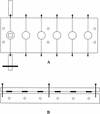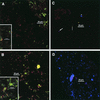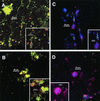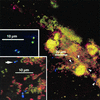Coaggregation-mediated interactions of streptococci and actinomyces detected in initial human dental plaque
- PMID: 12754239
- PMCID: PMC155391
- DOI: 10.1128/JB.185.11.3400-3409.2003
Coaggregation-mediated interactions of streptococci and actinomyces detected in initial human dental plaque
Abstract
Streptococci and actinomyces that initiate colonization of the tooth surface frequently coaggregate with each other as well as with other oral bacteria. These observations have led to the hypothesis that interbacterial adhesion influences spatiotemporal development of plaque. To assess the role of such interactions in oral biofilm formation in vivo, antibodies directed against bacterial surface components that mediate coaggregation interactions were used as direct immunofluorescent probes in conjunction with laser confocal microscopy to determine the distribution and spatial arrangement of bacteria within intact human plaque formed on retrievable enamel chips. In intrageneric coaggregation, streptococci such as Streptococcus gordonii DL1 recognize receptor polysaccharides (RPS) borne on other streptococci such as Streptococcus oralis 34. To define potentially interactive subsets of streptococci in the developing plaque, an antibody against RPS (anti-RPS) was used together with an antibody against S. gordonii DL1 (anti-DL1). These antibodies reacted primarily with single cells in 4-h-old plaque and with mixed-species microcolonies in 8-h-old plaque. Anti-RPS-reactive bacteria frequently formed microcolonies with anti-DL1-reactive bacteria and with other bacteria distinguished by general nucleic acid stains. In intergeneric coaggregation between streptococci and actinomyces, type 2 fimbriae of actinomyces recognize RPS on the streptococci. Cells reactive with antibody against type 2 fimbriae of Actinomyces naeslundii T14V (anti-type-2) were much less frequent than either subset of streptococci. However, bacteria reactive with anti-type-2 were seen in intimate association with anti-RPS-reactive cells. These results are the first direct demonstration of coaggregation-mediated interactions during initial plaque accumulation in vivo. Further, these results demonstrate the spatiotemporal development and prevalence of mixed-species communities in early dental plaque.
Figures






Similar articles
-
Characterization of a Streptococcus sp.-Veillonella sp. community micromanipulated from dental plaque.J Bacteriol. 2008 Dec;190(24):8145-54. doi: 10.1128/JB.00983-08. Epub 2008 Sep 19. J Bacteriol. 2008. PMID: 18805978 Free PMC article.
-
Genetic basis of coaggregation receptor polysaccharide biosynthesis in Streptococcus sanguinis and related species.Mol Oral Microbiol. 2014 Feb;29(1):24-31. doi: 10.1111/omi.12042. Mol Oral Microbiol. 2014. PMID: 24397790 Free PMC article.
-
Identification of independent Streptococcus gordonii SspA and SspB functions in coaggregation with Actinomyces naeslundii.Infect Immun. 2001 Dec;69(12):7512-6. doi: 10.1128/IAI.69.12.7512-7516.2001. Infect Immun. 2001. PMID: 11705927 Free PMC article.
-
Specific inhibitors of bacterial adhesion: observations from the study of gram-positive bacteria that initiate biofilm formation on the tooth surface.Adv Dent Res. 1997 Apr;11(1):168-75. doi: 10.1177/08959374970110010801. Adv Dent Res. 1997. PMID: 9524453 Review.
-
Molecular basis of bacterial adhesion in the oral cavity.Rev Infect Dis. 1987 Sep-Oct;9 Suppl 5:S467-74. doi: 10.1093/clinids/9.supplement_5.s467. Rev Infect Dis. 1987. PMID: 2891180 Review.
Cited by
-
Secreted products of oral bacteria and biofilms impede mineralization of apical papilla stem cells in TLR-, species-, and culture-dependent fashion.Sci Rep. 2018 Aug 21;8(1):12529. doi: 10.1038/s41598-018-30658-5. Sci Rep. 2018. PMID: 30131595 Free PMC article.
-
Bond strengthening in oral bacterial adhesion to salivary conditioning films.Appl Environ Microbiol. 2008 Sep;74(17):5511-5. doi: 10.1128/AEM.01119-08. Epub 2008 Jul 18. Appl Environ Microbiol. 2008. PMID: 18641154 Free PMC article.
-
Molecular analysis of endotracheal tube biofilms and tracheal aspirates in the pediatric intensive care unit.Adv Pediatr Res. 2017 Dec;4(3):14. doi: 10.12715/apr.2017.4.14. Epub 2017 Nov 10. Adv Pediatr Res. 2017. PMID: 29963643 Free PMC article.
-
Contribution of phosphoglucosamine mutase to determination of bacterial cell morphology in Streptococcus gordonii.Odontology. 2012 Jan;100(1):28-33. doi: 10.1007/s10266-011-0026-1. Epub 2011 May 13. Odontology. 2012. PMID: 21567120
-
Genomic library screening for viruses from the human dental plaque revealed pathogen-specific lytic phage sequences.Curr Microbiol. 2012 Jan;64(1):1-6. doi: 10.1007/s00284-011-0025-z. Epub 2011 Oct 4. Curr Microbiol. 2012. PMID: 21969025
References
-
- Buswell, C. M., Y. M. Herlihy, P. D. Marsh, C. W. Keevil, and S. A. Leach. 1997. Coaggregation amongst aquatic biofilm bacteria. J. Appl. Microbiol. 83:477-484.
-
- Cisar, J. O., M. J. Brennan, and A. L. Sandberg. 1985. Lectin-specific interaction of Actinomyces fimbriae with oral streptococci, p. 159-163. In S. E. Mergenhagen and B. Rosan (ed.), Molecular basis of oral microbial adhesion. American Society for Microbiology, Washington, D.C.
MeSH terms
Substances
LinkOut - more resources
Full Text Sources
Medical
Molecular Biology Databases

